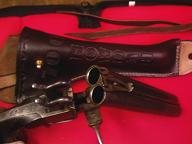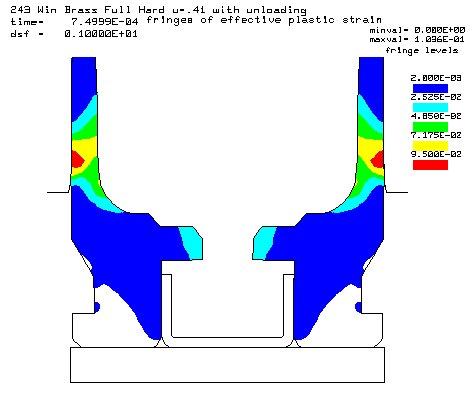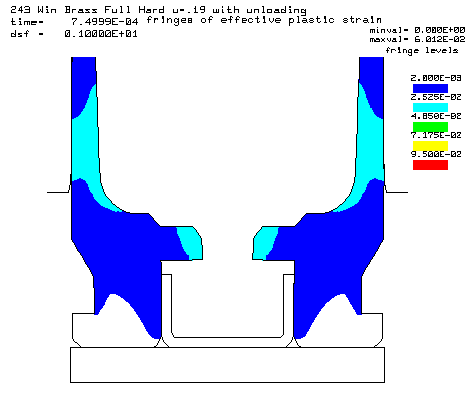

 The Accurate Reloading Forums
The Accurate Reloading Forums  THE ACCURATE RELOADING.COM FORUMS
THE ACCURATE RELOADING.COM FORUMS  Guns, Politics, Gunsmithing & Reloading
Guns, Politics, Gunsmithing & Reloading  Gunsmithing
Gunsmithing  Measuring bolt thrust
Measuring bolt thrustGo  | New  | Find  | Notify  | Tools  | Reply  |  |
| one of us |
Al--Did you use half hard strength for base and sides, in the calculations and analysis.Most cases will be full-hard in the head changing to half-hard on the sides.Although some of the 450NE brass I used to build my 458 wildcat seemed 3/4 hard the way it acted. Then others were so hard in the head they wouldn't expand a bit, but they went from that real hard head to real soft sides to quick,And wouldn't last the number of reloads like the other brass before they separated...Ed. | |||
|
one of us |
Thanks. I read in a book on cartrige conversions about soldering a tube onto a case to make it longer and that if it was heated on a hot plate till it would melt the solder then turn the hot plate off and let the cartrige cool that it would optimize the hardness of the brass. I was at the jewlers the other day also and got to talking about the properties of silver. She showed me a reference book on heating sliver to XXX deg then holding for XXX min then cooling slowly to bring it to half hard and that a reduction in size of xx% would bring to to full hard then an aditional to spring hard. I was wondering if Brass had a similar property since we can soften it by heating and quenching vs a similar treatment to steel would harden it. ???????????? | |||
|
| one of us |
hubel458, The first series of calculations were done with Half Hard brass in the case head and walls. The shoulder and neck were annealed brass at a yield stress of 19 ksi. The peak pressure was 50,000 psi for the 243 Win case. Down near the bottom of the page, I did a side by side comparison of the brass in the Full Hard condition and the peak pressure was 55,000 psi. Again the shoulder and neck were the annealed condition. The whole series of calculations will be repeated once the test results are complete on measuring the friction coefficients. I will also write up a page on the tests to determine friction for various 416 stainless steel finishes.  Here is the Full Hard brass at 55,000 psi and the fringes of effective plastic strain and a friction coefficient of 0.41  The same conditions except the friction coefficient is 0.19. Stretching the brass with the higher friction only relieves the bolt load by about 450 lb. The point of the calculation was to dispel the myth that the bolt load would be too high if the chamber were to have a smooth finish. | |||
|
| one of us |
Al--Keep up the great work--I found in reality that smooth chambers are the best for the brass and never saw any extra bolt thrust that showed by the action on the bolt in gaining headspace, even with max loads.For my wildcats I made sure that the back part of the chamber was real smooth. With my 458HE I can reload cases with low speed(2000 fps) 350 gr bullets and not have to resize.Ed | |||
|
| Powered by Social Strata | Page 1 2 |
| Please Wait. Your request is being processed... |
|

Visit our on-line store for AR Memorabilia

